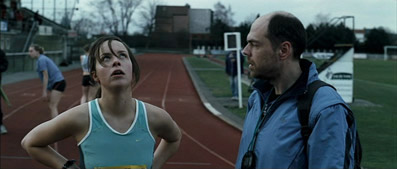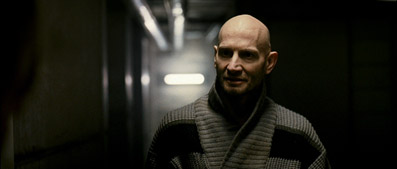|
Isn't it nice when just a couple of minutes into a film, you just know you're in for something a little bit special? This is especially true of the modern horror movie, which has become overrun with remakes, rip-offs and plotless low-budget fan-boy slashers. It's that feeling you get when a filmmaker with a real command of their craft knows they don't have to hit the audience over the head to get it hooked. They understand that building unease can be a lot more effective than screaming "Boo!" every five minutes, and that it's a lot easier for us to connect with a human being than a cardboard cipher.
The human in question here is Marie, a young professional athlete who lives with her mother and is training vigorously for the European Championships in Portugal. Despite qualifying for a place, her hopes are dashed when she collapses and is ordered to rest for a month to give her damaged immune system time to heal. She moves in with good-looking young car salesman Bobby, head of the local Archer's Guild, with whom she has just begun a relationship and whose Left Bank apartment offers a view of the Schelde River, just the sort of place to relax and recuperate. But her continued ill health, troubling dreams, and the news that the apartment's previous occupant vanished without trace prompts Marie to continue research begun by the girl who went missing into the links between the area and past pagan rituals.

From the moment we meet her, there's a pall hanging over Marie that's as tangible as the overcast skies and leafless trees that seem to envelop Bobby's Left Bank apartment block. Nothing is forced or overstated, and the first half of the film plays more like a psychological drama than our common perception of a (modern) horror movie, particularly in its almost subjective focus on Marie and her differing relationships with her mother (familial), Bobby (sexual) and Dirk, the boyfriend of the missing girl and her co-investigator, whose friendship threatens to drive a wedge between her and her jealous boyfriend.
The story unfolds as a process of gradual decay, a series of encounters and small discoveries that while innocuous in themselves, collectively help to build a palpable sense of anxiety. This is amplified by a combination of Simon Lenski and Eavesdropper's mournful score, Senjan Jansen and Mathieu Cox's unsettling sound design, and Nicolas Karakatsanis' immaculately composed scope cinematography, its precision framed static shots and slow camera movements occasionally exploding in an emotion-fuelled frenzy of instability, framing elements of the Left Bank landscape as a series of abstract images whose haunting beauty is worthy of gallery exhibition.
The prevailing mood is matched by impressively low key performances across the board. Eline Kuppens in particular excels as Marie, her fearless nudity allowing her post-diagnosis misery and isolation to be captured in a single shot of her weeping in the shower, while a passionate sex scene provides a convincing reason for her to move in with a man she's only recently met. Such cinematic economy allows director Pieter Van Hees to effectively have his cake and eat it, moving the story along at a respectable pace whilst maintaining an air of brooding stillness laced with a meaningful use of Freudian imagery and visually unsettling dreams, intermittently punctuated by moments of sudden and energetic urgency.

Where the film falls down a little is in what this compelling build-up is actually leading to, and without wanting to give too much away I can reveal that we've definitely been here before, and on at least two occasions in works that have achieved the status of genre classics. While I've no intention of naming them here, you won't have to look far to find someone else who is happy to do so, and if you're familiar with any of the earlier works (and trust me, if you're a genre fan you will be) then there's a good chance you'll work out what's going on before the film is ready to reveal it.
This leaves me feeling uncertain whether the second-hand nature of later plot developments cancels out the atmospheric scene setting and compelling slow reveal of the first two-thirds. It's a subjective call, of course, but despite the disappointment that comes from realising that the newcomer you've been so entranced by is actually just an old friend in disguise, I'd argue that there's just too much good stuff in the early and even later stages to write off the film on the basis of its narrative borrowings. Yes, it walks in the footsteps of giants, but it does so with confidence, style and an attention to character, location and atmosphere that frankly wipes the floor with the current crop of American and UK horrors, and strongly suggests that if they got their hands on a genuinely original idea, the collective talent here could give birth to a film that will make Belgian horror cinema a force to be reckoned with.
A clear and richly detailed 2.35:1 anamorphic transfer that may seem a bit dark in the accompanying frame grabs, but this clearly a deliberate look (there are plenty of brighter scenes to balance and confirm this) and a key aspect of both the film's treacle-thick atmosphere and Nicolas Karakatsanis' haunting cinematography, as are the prevailing earthy tones. Pleasingly, it copes well with even the darkest scenes, retaining the detail without diluting the black levels, and coping even with the occasional dip into light levels low enough to give Lost Highway a run for its money.

The original Dutch soundtrack is available both in Dolby 2.0 stereo and Dolby 5.1 surround. Roughly equal in overall volume, it's the surround track that wins out on finesse (the stereo track doesn't feel quite as finely tuned), really showing its worth in the volume, clarity and bass wallop of the music that plays at the club, at the later party, and in Bobby car, and in the make-you-jump crack of the starting pistol at Marie's qualifying race. The music sounds lovely throughout.
Production Diary (12:10)
A commentary-free peek at the preparation for and filming of a few key scenes. Too brief to provide much in the way of insight and lacking any verbal input from cast or crew members, it nonetheless does put a few faces to crew names.
Deleted Scenes (6:32)
Presented in good quality anamorphic 2.35:1 rather than the usual timecoded letterbox format, this is a useful collection of short sequences trimmed from the final cut, most of them providing additional detail on Marie or what is happening to her. Also thrown in are three outtakes of Bobby opening a door that's supposed to be locked.
There's also a seductive (and adult targeted) Theatrical Trailer (1:52), an even more enigmatic Teaser Trailer (0:46), and a Stills Gallery (1:29) consisting of stills from the film, plus a poster and press release.
A compellingly made and performed exercise in slow-build unease that could prove a breakthrough film for Belgian genre cinema if it finds an audience outside of home turf. That it ultimately treads a path already well walked by some notable forebears is a shame, particularly given the obvious talent and imagination of those involved, but it's still well worth seeing for the manner in which that story unfolds. The extras are not bad, but it's the picture and sound quality that make Exposure Cinema's DVD worth the purchase price.
|